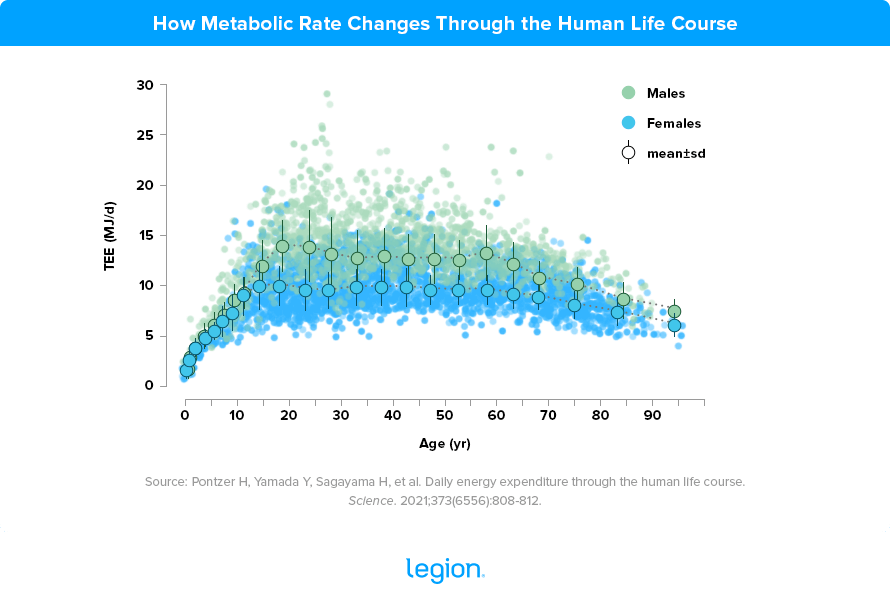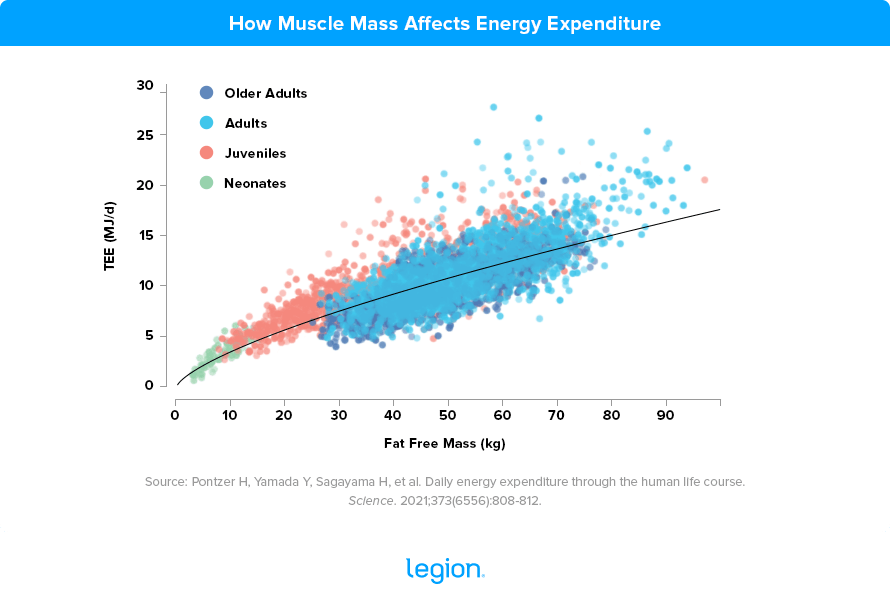Does Your Metabolism Slow With Age?
Most people think that age and metabolism are inversely correlated.
They think metabolism slows with age, which is why many people begin gaining weight in their late 20s and early 30s.
You often see this idea parroted in the media as if it’s conclusively proven, but science shows this isn’t the case.
In this article, you’ll learn the surprising truth about metabolism and age—and it’s much more rosy than you might think.
- What Is Your Metabolism?
- How Scientists Study Metabolism
- When Does Your Metabolism Slow Down?
- Neonates
- Juveniles
- Adults
- Older Adults
- Limitations
- How to Increase Your Metabolic Rate
- Physical Activity
- Diet
- Supplements
- Conclusion
- FAQ #1: Does metabolism slow with age?
- FAQ #2: What age does metabolism slow down?
- FAQ #3: Why does metabolism slow down with age?
Table of Contents
What Is Your Metabolism?
Metabolism refers to the physical and chemical processes that occur throughout your body that turn the energy (calories) in the food you eat into bodily functions.
There are four main components of metabolism:
1. Basal metabolic rate (BMR): BMR is the number of calories your body burns performing basic vital functions, such as breathing, pumping blood around your body, and maintaining brain function.
BMR accounts for ~60% of your total daily energy expenditure (TDEE).
2. Thermic effect of food (TEF): TEF is the number of calories you burn digesting the food you eat. The biggest determinant of TEF is the macronutrient composition of your meals: protein has a TEF of ~20-to-30%, carbs have a TEF of ~5-to-10%, and fat has a TEF of ~0-to-3%.
This means, for example, that if you eat 100 calories of protein, your body burns 20-to-30 calories digesting it.
TEF is also affected by the level of processing food undergoes (the less processed a food is, the higher its TEF) and the amount of food you eat in one sitting (larger meals cause a bigger increase in TEF than smaller ones).
TEF accounts for ~10% of your TDEE.
3. Exercise activity thermogenesis (EAT): EAT is the number of calories you burn doing formal exercise. As such, the number of calories burned through EAT varies depending on the amount and type of exercise you do.
4. Non-exercise activity thermogenesis (NEAT): NEAT is the number of calories you burn from any activity that isn’t formal exercise—fidgeting at your desk, pacing around while talking on the phone, walking from your car to the office, and so forth.
NEAT varies greatly between people, but it accounts for about 300 calories per day for most people.
How Scientists Study Metabolism
Most large-scale studies on metabolic rate only measure BMR, which, as we’ve already seen, only accounts for a portion of the total calories you burn each day.
There are, however, more accurate ways to measure metabolic rate.
One such method is referred to as the “doubly labeled water” method. This involves having someone drink water containing forms of hydrogen and oxygen that are traceable in urine. Scientists then analyze people’s pee to track how much hydrogen and oxygen they excrete. Based on the results, they can calculate how much carbon dioxide (CO2) the person’s body produces.
Every calorie burned produces a precise amount of CO2, so by calculating how much CO2 people produce, you can very accurately estimate how many calories they burn.
Scientists have been using doubly labeled water to measure metabolic rate since the 1980s. Unfortunately, most studies that use doubly labeled water are small and limited to affluent areas because they’re expensive, so the results are difficult to apply universally.
In 2021, scientists from 63 universities sought to rectify this by pooling data from almost 6,500 people aged between 8 days and 95 years old from 29 different countries that had all participated in studies using doubly labeled water.
By lumping this data together, the researchers hoped to spot trends that smaller studies with fewer subjects might miss.
The main question they wanted to answer was: When does your metabolism slow down?
When Does Your Metabolism Slow Down?
The scientists split the results into four life stages: neonates (0-to-1 year old), juveniles (1-to-20 years old), adults (20-to-60 years old), and older adults (60+ years old).
Let’s review their findings for each stage.
Neonates
Most people think your metabolic rate is highest during adolescence, but the results from this study show that your metabolism is faster (relative to your body weight) during your first year of life than at any other point.
Specifically, the scientists found that around a child’s first birthday, their metabolic rate is almost 50% higher for their size than an adult’s.
Remember—we’re talking about your metabolic rate relative to your body weight. Infants grow quickly and are small, so it makes sense their metabolism would be abnormally high.
Juveniles
Metabolic rate continues to increase throughout childhood and adolescence. Once you account for growing body size, however, the numbers aren’t as striking as during the neonatal stage.
Instead of metabolic rate being ~50% higher than an adult’s when you adjust for body size, “size-adjusted” energy expenditure declines by ~3% per year until the age of 20, at which point it stabilizes.
Interestingly, this challenges the common belief that teenagers must consume more calories to fuel growth spurts. In reality, their relative calorie needs are almost the same as adults. The real reason teenagers can eat so much while staying lean? They’re generally very active.
Adults
Most people believe that our metabolisms slowly decline between the ages of 20 and 60, causing us to gradually gain weight.
The results from this study suggest otherwise, though.
The scientists found that throughout adulthood, metabolic rate remains stable for both men and women. This is even true during pregnancy when women require no more calories than you’d expect once you account for the baby’s weight.
Older Adults
After the age of 60, our metabolisms decline a bit less than 1% per year. Thus, by 90 years old, your metabolic rate will be ~25% slower than when you were 60.
Here’s a chart taken from the study that illustrates how your metabolism changes as you age. Notice that between the ages of 20 and 60, metabolism remains stable:

One reason for this is that as we age, our organs burn fewer calories performing the functions that keep us alive, lowering our basal metabolic rate.
This decline in metabolic rate isn’t entirely out of our control, though. The primary reason most people’s metabolic rates decline is that they lose muscle (because they don’t lift weights or eat enough protein).
Muscle is an energy-hungry tissue, which means it burns a significant number of calories even when you’re resting. When you lose it, your metabolic rate dips.
Limitations
This study is exceptionally strong—it used the “gold-standard” method of measuring metabolic rate and involved thousands of people from all over the world with different ages and backgrounds.
As such, we can trust what it tells us about how metabolic rate changes as we age.
However, there’s still one limitation worth discussing: the researchers only measured each person’s metabolic rate at a single point in time.
That is, they didn’t track each person from birth until death, recording how their metabolism changed over time. Instead, they measured the metabolic rate of thousands of 0-to-95 year olds once, adjusted the data so they could compare each person despite differences in height, weight, muscle mass, and so forth, then used the data to calculate an average metabolic rate for each age.
While this data is revealing, it can’t tell us how metabolic rate would change for a single person over time if they built or lost a significant amount of muscle.
Given that the authors also found that the more fat-free mass (everything in your body that isn’t body fat, mainly muscle, bones, and organs) you have, the higher your energy expenditure, it’s reasonable to assume that building muscle will increase metabolic rate, and losing muscle will have the opposite effect.
Here’s a graph from the study illustrating this:

(The y-axis on this graph represents energy expenditure measured in megajoules per day. One megajoule equals ~240 calories.)
Note that there are many older folks who actually have higher metabolic rates than their young or middle-aged peers thanks to being more jacked.
And this brings us to an important point about metabolism: Many people think their “metabolism” is a mysterious process that’s entirely outside their control, but this isn’t true. You can positively influence every part of your metabolism.
Here’s how . . .
How to Increase Your Metabolic Rate
Here’s how to increase your metabolic rate using physical activity, diet, and supplements.
Physical Activity
Increasing your physical activity is the best way to boost your metabolic rate.
Weightlifting is particularly effective because it significantly increases your BMR. One way it does this is by helping you build muscle.
In fact, the researchers in the study referenced a moment ago and others note that ~80% of the variability in BMR from person to person can be explained by how much muscle a person has.
In other words, the main difference between people with “fast” metabolisms and those with “slow” metabolisms is how much muscle they have. People with faster metabolisms have more muscle, and people with slower metabolisms have less.
(If you want an exercise program that’ll help you build muscle like clockwork, check out Mike Matthews’ best-selling fitness books for men and women, Bigger Leaner Stronger and Thinner Leaner Stronger.)
Increasing NEAT is more complicated since how much you fidget seems to be largely genetic.
That said, if you’re looking for ways to increase your energy expenditure outside of formal exercise, here are some suggestions:
- If you sit for long periods each day and aren’t prone to fidgeting, try to work while standing. When you get tired, take a seat, but aim to gradually increase the time you spend on your feet each day (within reason).
- Spend 20-to-30 minutes per day walking briskly. Use this time to talk on the phone, listen to a podcast or audiobook, or simply enjoy some peaceful headspace.
- Don’t sit when you can stand.
- Don’t stand still when you can move. For example, pace back and forth while you brush your teeth.
- Don’t drive or take an elevator or escalator when you can walk.
Diet
The only way to boost your metabolism with diet is to increase TEF, and the best way to do this is to eat more protein.
Consuming 1 gram of protein per pound of body weight per day is an excellent place to start for most people.
High-protein dieting also helps you build muscle, which, as we’ve already seen, effectively increases your BMR, boosting your metabolism further.
(And if you’d like even more specific advice about how much of each macronutrient, how many calories, and which foods you should eat to reach your health and fitness goals, take the Legion Diet Quiz and in less than a minute, you’ll know exactly what diet is right for you. Click here to check it out.)
Supplements
There are a handful of natural, safe supplements that increase your metabolic rate, such as caffeine, Thai ginseng, Grains of Paradise, and yohimbine (which you can find in Legion’s fat burner supplements Phoenix and Forge).
The catch, though, is that you should only use these ingredients while dieting to lose weight—they won’t help you lose weight or maintain a healthy weight unless you also restrict your calorie intake. Most stimulants, including caffeine and yohimbine, also gradually become less effective at quickening your metabolism over time.
One metabolism-boosting supplement that you can take forever is protein powder. It’s safe to use long term, tastes good, and doesn’t lose its effectiveness over time.
There’s nothing inherently superior about protein powder versus other high-protein foods, but it’s a convenient way to ensure you always hit your protein target (which should generally be about 1 gram of protein per pound of body weight per day).
For example, you could swap a high-carb daily snack like fruit salad or granola bar with a protein shake to significantly increase your protein intake.
Bear in mind, though, taking protein powder won’t help you maintain your weight unless you also maintain neutral energy balance (eat approximately the same number of calories as you burn each day).
If you want a clean, convenient, and delicious source of protein powder, try Whey+ or Casein+.
(Or if you aren’t sure if Whey+ or Casein+ is right for you or if another supplement might be a better fit for your budget, circumstances, and goals, take the Legion Supplement Finder Quiz! In less than a minute, it’ll tell you exactly what supplements are right for you. Click here to check it out.)
Conclusion
One of the best studies conducted to date on metabolism shows that many of our ideas about how metabolism changes with age are wrong.
Metabolic rate remains constant between the ages of 20 and 60, which means any weight we gain during this time—the so-called “middle age spread”—isn’t caused by our slumping metabolism but because we consume more calories than we burn.
The good news is that you can increase your metabolism by changing a few simple habits. Namely, being more active (and ideally, lifting weights) and eating more protein.
FAQ #1: Does metabolism slow with age?
Yes, but not as early as many people believe.
Until your first birthday, your metabolic rate is sky-high. After this initial surge, it slowly declines until you’re 20, settles, then remains constant until you’re about 60. Once you reach 60 years old, your metabolism begins to decline, decreasing by just under 1% per year (although this is largely due to muscle loss and inactivity).
FAQ #2: What age does metabolism slow down?
Most people think your metabolism slows after age 20, but this isn’t the case.
Your metabolism remains stable between the ages of 20 and 60, after which it slowly declines by just under 1% per year.
FAQ #3: Why does metabolism slow down with age?
There are two primary reasons your metabolism slows after the age of 60:
- You begin to lose muscle, which means you burn fewer calories while moving and at rest.
- Your organs burn fewer calories performing the functions that keep you alive.
While you can’t do much about number 2, you can influence number 1 by lifting weights.
(And if you’d like specific advice about which training program you should follow to reach your health and fitness goals, take the Legion Strength Training Quiz, and in less than a minute, you’ll know the perfect strength training program for you. Click here to check it out.)
The post Does Your Metabolism Slow With Age? appeared first on Legion Athletics.
https://ift.tt/ofa7nyS November 29, 2022 at 06:00PM Legion Athletics

Comments
Post a Comment